Verlinden 120mm WWII British Paratrooper
|
KIT #: |
2755 |
|
PRICE: |
$24.95
|
|
DECALS: |
N/A |
|
REVIEWER: |
Blair Stewart |
|
NOTES: |
Resin |
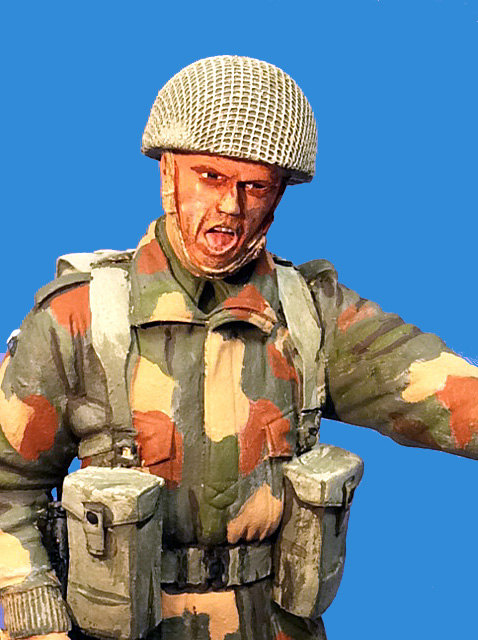 The Parachute Regiment, or “Paras,” is an airborne
infantry regiment of the British Army. The Parachute Regiment was formed in 1941
during the Second World War and eventually raised 17 battalions. In European
Theater, these battalions formed part of the 1st Airborne Division, the 6th
Airborne Division and the 2nd Independent Parachute Brigade Group. Another three
battalions served with the British Indian Army in India and Burma. The regiment
took part in six major parachute assault operations in North Africa, Italy,
Greece, France, the Netherlands and Germany, often landing ahead of all other
troops.
The Parachute Regiment, or “Paras,” is an airborne
infantry regiment of the British Army. The Parachute Regiment was formed in 1941
during the Second World War and eventually raised 17 battalions. In European
Theater, these battalions formed part of the 1st Airborne Division, the 6th
Airborne Division and the 2nd Independent Parachute Brigade Group. Another three
battalions served with the British Indian Army in India and Burma. The regiment
took part in six major parachute assault operations in North Africa, Italy,
Greece, France, the Netherlands and Germany, often landing ahead of all other
troops.
Impressed by the success of German
airborne operations during the Battle of France, British Prime Minister Winston
Churchill directed the War Office to investigate the possibility of creating a
corps of 5,000 parachute troops. On 22 June 1940, No. 2 Commando was turned over
to parachute duties and on 21 November, re-designated the 11th Special Air
Service Battalion, which contained a parachute and glider wing.
This unit conducted the first British airborne operation,
Operation Colossus, on 10 February 1941. In September, the battalion was
re-designated the 1st Parachute Battalion and assigned to the 1st Parachute
Brigade. To fill out the brigade, the British Army called for volunteers from
all its units.
The first operation by the Parachute Regiment was
Operation Biting in February 1942. The objective was to capture a Würzburg radar
on the coast of France. The raid was carried out by 'C' Company, 2nd Parachute
Battalion, under the command of Major John Frost.
Probably the most famous World War II action involving
the Parachute Regiment was Operation Market Garden. Operation Market Garden
(17–25 September 1944) was an unsuccessful Allied military operation in the
Netherlands and Germany. The operation’s name came from its two sub-operations:
Market - the airborne forces, consisting of the First Allied Airborne Army, who
would seize the major bridges; and Garden - the ground forces, consisting of the
British XXX Corps. Market Garden was the largest airborne operation up to that
point in the war.
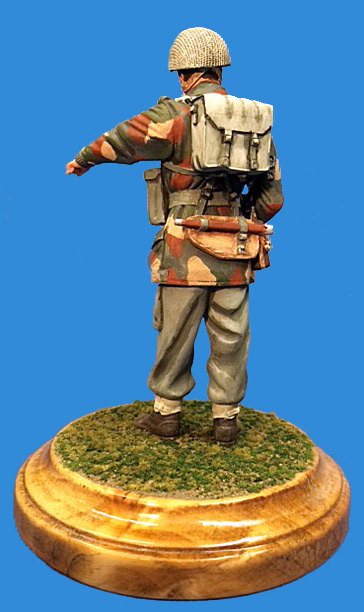 Field Marshal Montgomery's strategic goal was to encircle
the heart of German industry, the Ruhr, in a pincer movement. The northern end
of the pincer would circumvent the northern end of the Siegfried Line, thereby
giving easier access into Germany. The aim of Market Garden was to establish the
northern end of a pincer ready to project force deeper into Germany. Allied
forces would project north from Belgium, 60 miles through Holland, across the
Rhine and then consolidate north of Arnhem on the Dutch/German border, where
they would then be ready to close the pincer.
Field Marshal Montgomery's strategic goal was to encircle
the heart of German industry, the Ruhr, in a pincer movement. The northern end
of the pincer would circumvent the northern end of the Siegfried Line, thereby
giving easier access into Germany. The aim of Market Garden was to establish the
northern end of a pincer ready to project force deeper into Germany. Allied
forces would project north from Belgium, 60 miles through Holland, across the
Rhine and then consolidate north of Arnhem on the Dutch/German border, where
they would then be ready to close the pincer.
The operation employed massed use of airborne forces,
whose tactical objectives were to secure the bridges and allow armored ground
units to advance rapidly and consolidate north of Arnhem. For its success, the
operation required the seizure of the bridges across the Maas (Meuse River), two
arms of the Rhine (the Waal and the Lower Rhine) as well as crossings over
several smaller canals and tributaries.
At the furthest point of the airborne
operation at Arnhem, the British 1st Airborne Division ran into unexpectedly
strong resistance. The delays in capturing the bridges at Son and Nijmegen
created time for German forces, including armored divisions, to move into Arnhem
from Germany. In the ensuing battle, only a small force of the 1st
Airborne Division managed to capture the north end of the Arnhem road bridge,
and after the ground forces failed to relieve them, the paratroopers were
overrun on 21 September. The remainder of the 1st Airborne Division was trapped
in a small pocket west of the bridge and had to be evacuated on 25 September.
Despite being the last great failure of the British Army,
Arnhem has become a byword for the fighting spirit of the British people and set
a standard for the Parachute Regiment. The British who participated in the
Arnhem battle returned to a heroes' welcome. Five of the British participants in
the battle were awarded Britain's highest award for gallantry, the Victoria
Cross. Four were members of the Airborne forces and one was from the RAF.
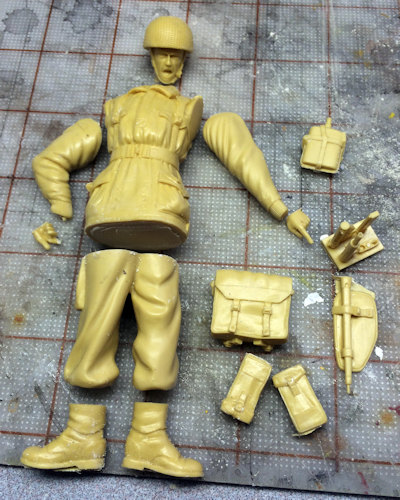 The figure is a detailed 120mm cast resin military figure
by Verlinden. As is typical of these figures, the kit comes in 18 separate cast
resin parts with some of them attached to resin casting blocks. The arms, hands,
torso and legs are separate components, as are the figure’s equipment. As usual,
the sculpting of the figure is extremely sharp with the great detail afforded by
the large 120mm scale. Of particular note is the Sten submachine gun, which is
made up from five separate pieces. Another feature of this figure is its action
pose, which is that of a trooper determinedly “barking” orders.
The figure is a detailed 120mm cast resin military figure
by Verlinden. As is typical of these figures, the kit comes in 18 separate cast
resin parts with some of them attached to resin casting blocks. The arms, hands,
torso and legs are separate components, as are the figure’s equipment. As usual,
the sculpting of the figure is extremely sharp with the great detail afforded by
the large 120mm scale. Of particular note is the Sten submachine gun, which is
made up from five separate pieces. Another feature of this figure is its action
pose, which is that of a trooper determinedly “barking” orders.
I began assembly by removing the various pieces from
their casting blocks and then cleaning them up. For the larger pieces, I use a
razor saw to cut the piece off the resin block, and then use a sharp Xacto knife
to clean things up.
As I have often experienced with these resin figures,
mating surfaces of the torso and legs were somewhat uneven once I removed the
casting block material, so I used a piece of sandpaper on a flat surface to
remove resin and provide a better mating surface for the parts (as I have noted
in my other resin figure reviews, exercise caution here if you use this method:
it’s easy to get carried away with the sanding and sand away more material than
you originally intended). I then used Super Glue to assemble the torso, legs,
arms and hands.
I had one glitch in my assembly: when I attempted to
remove the pieces of the finely detailed Sten gun from their casting block, I
managed to break the fragile butt plate for the T stock, so I fashioned another
one out of plastic card stock and drilled the appropriate holes to mate it to
the stock.
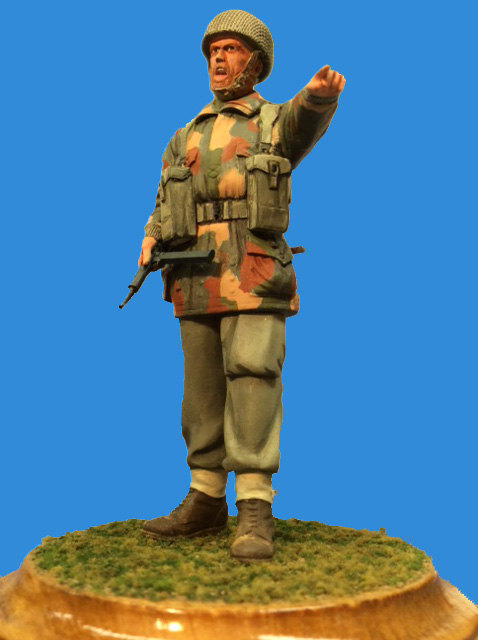 To prep the figure, I drilled some holes in the boot
bottoms, inserted some sections of a paper clip, and then attached the figure to
a piee of wood to facilitate painting. I began by spraying the figure with
Testors flat white enamel through my Paasche airbrush to serve as the base coat
and provide a light base for subsequent hand painting with a combination of
acrylics and enamels.
To prep the figure, I drilled some holes in the boot
bottoms, inserted some sections of a paper clip, and then attached the figure to
a piee of wood to facilitate painting. I began by spraying the figure with
Testors flat white enamel through my Paasche airbrush to serve as the base coat
and provide a light base for subsequent hand painting with a combination of
acrylics and enamels.
I then began the hand painting of the figure. I started
by painting the head and hands with Testors flat flesh enamel. As always, with
figures, a major challenge is the skin tones, and then the proper shading to get
some kind of expression on the face. I mixed some Testors flat white with the
flesh paint and highlighted raised portions of the figure’s face and hands. I
dry brushed some burnt umber around the figure’s mouth to simulate a day or two
of beard growth.
Next, I painted the eyes. For figures like this one that
are in an action pose, one can generally get by with a “squinting” look that
does not require a painted eyeball. But this figure clearly has open eyes due to
his rather emphatic look as he barks out an order. I used Testors flat white to
paint in oblong eyeballs, then some acrylic black to represent the irises. As
always, the key to achieving realistic eyes is to then paint a bottom and top
lid over the white eyeball so that the figure doesn’t have that’s total
“bug-eyed” look.
For most of the other parts of the figure, I primarily
used relatively inexpensive flat acrylic paints. For the uniform trousers, I
started with Vallejo German Field Gray and lightened it slightly with a little
white. I also used this paint for the ammo pouches, pack, and equipment straps.
For the jacket camouflage, I used a combination of Americana Burnt Sienna,
Craftsmart Golden Brown and Olive Green, and Vallejo German Field Gray that I
darkened slightly with flat black.
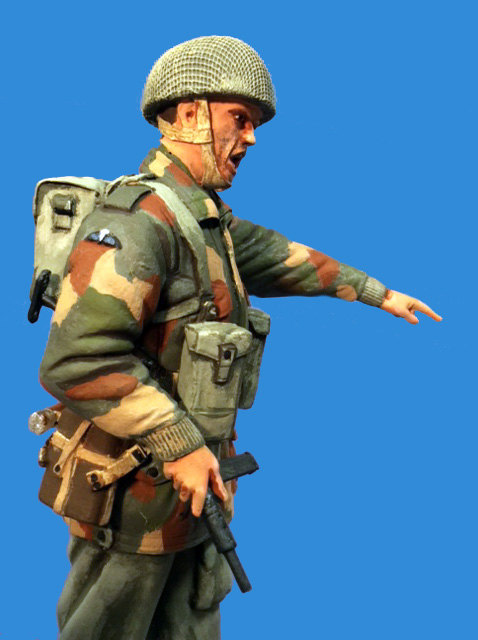 I painted the trooper’s boots with Americana Raw Umber,
and then used Americana Khaki for the leggings. For the helmet, I first painted
it with Vallejo Field Gray, and then I lightly dry brushed Americana Khaki over
the netting to highlight it and make it stand out from the helmet.
I painted the trooper’s boots with Americana Raw Umber,
and then used Americana Khaki for the leggings. For the helmet, I first painted
it with Vallejo Field Gray, and then I lightly dry brushed Americana Khaki over
the netting to highlight it and make it stand out from the helmet.
Once I finished all of these colors, I then went back
over the figure with increasingly darker shades of each color in the folds and
highlights of the uniform and equipment to provide additional definition and
shading.
I like to display my figures on wooden
bases purchased from Hobby Lobby or Michaels, and I generally apply some sort of
soil or sand base to these. I first stained the base with several coats of Watco
Danish Oil. Once this dried, I then rattle canned on several coats of Rustoleum
Clear Gloss to give the base that polished wood look. I then drilled holes in
the wooden base and attached the figure with the previously attached paper clip
pens I had inserted in the boot bottoms. I brushed on a coat of Elmer’s white
glue, and then sprinkled sifted, fine soil onto the glue. While the glue was
still wet, I then sprinkled a combination of Woodland Scenics Medium Green
Coarse Turf (No. T1364) and Burnt Grass Coarse Turf (No. T1362). To make sure
this adhered to the base, I sprinkled diluted white glue on these materials.
Well, I suppose I am exhibiting an
“obsession” with figure modeling, and here’s another one (for all you aircraft
modelers, I promise I actually have an almost completed Academy 1/48 F-4B on my
work bench that, God willing and the creek don’t rise, I can work up a review on
in the near future). As usual, Verlinden has hit another home run with this
figure. When completed, it is a nice tribute to the British Paras of World War
II.
-
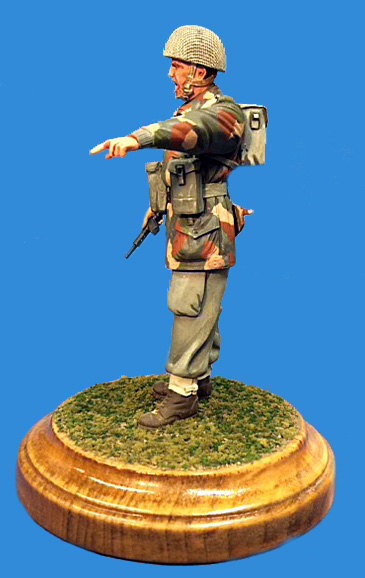 Parachute Regiment (United Kingdom),
Wikipedia, April 2016.
Parachute Regiment (United Kingdom),
Wikipedia, April 2016.
-
Battle of Arnhem,
Wikipedia, April 2016.
Blair Stewart
May 2016
Copyright ModelingMadness.com
If you would like your product reviewed fairly and
fairly quickly, please
contact
the editor or see other details in the
Note to
Contributors.
Back to the Main Page
Back to the Review
Index Page
 The Parachute Regiment, or “Paras,” is an airborne
infantry regiment of the British Army. The Parachute Regiment was formed in 1941
during the Second World War and eventually raised 17 battalions. In European
Theater, these battalions formed part of the 1st Airborne Division, the 6th
Airborne Division and the 2nd Independent Parachute Brigade Group. Another three
battalions served with the British Indian Army in India and Burma. The regiment
took part in six major parachute assault operations in North Africa, Italy,
Greece, France, the Netherlands and Germany, often landing ahead of all other
troops.
The Parachute Regiment, or “Paras,” is an airborne
infantry regiment of the British Army. The Parachute Regiment was formed in 1941
during the Second World War and eventually raised 17 battalions. In European
Theater, these battalions formed part of the 1st Airborne Division, the 6th
Airborne Division and the 2nd Independent Parachute Brigade Group. Another three
battalions served with the British Indian Army in India and Burma. The regiment
took part in six major parachute assault operations in North Africa, Italy,
Greece, France, the Netherlands and Germany, often landing ahead of all other
troops.  Field Marshal Montgomery's strategic goal was to encircle
the heart of German industry, the Ruhr, in a pincer movement. The northern end
of the pincer would circumvent the northern end of the Siegfried Line, thereby
giving easier access into Germany. The aim of Market Garden was to establish the
northern end of a pincer ready to project force deeper into Germany. Allied
forces would project north from Belgium, 60 miles through Holland, across the
Rhine and then consolidate north of Arnhem on the Dutch/German border, where
they would then be ready to close the pincer.
Field Marshal Montgomery's strategic goal was to encircle
the heart of German industry, the Ruhr, in a pincer movement. The northern end
of the pincer would circumvent the northern end of the Siegfried Line, thereby
giving easier access into Germany. The aim of Market Garden was to establish the
northern end of a pincer ready to project force deeper into Germany. Allied
forces would project north from Belgium, 60 miles through Holland, across the
Rhine and then consolidate north of Arnhem on the Dutch/German border, where
they would then be ready to close the pincer. The figure is a detailed 120mm cast resin military figure
by Verlinden. As is typical of these figures, the kit comes in 18 separate cast
resin parts with some of them attached to resin casting blocks. The arms, hands,
torso and legs are separate components, as are the figure’s equipment. As usual,
the sculpting of the figure is extremely sharp with the great detail afforded by
the large 120mm scale. Of particular note is the Sten submachine gun, which is
made up from five separate pieces. Another feature of this figure is its action
pose, which is that of a trooper determinedly “barking” orders.
The figure is a detailed 120mm cast resin military figure
by Verlinden. As is typical of these figures, the kit comes in 18 separate cast
resin parts with some of them attached to resin casting blocks. The arms, hands,
torso and legs are separate components, as are the figure’s equipment. As usual,
the sculpting of the figure is extremely sharp with the great detail afforded by
the large 120mm scale. Of particular note is the Sten submachine gun, which is
made up from five separate pieces. Another feature of this figure is its action
pose, which is that of a trooper determinedly “barking” orders. To prep the figure, I drilled some holes in the boot
bottoms, inserted some sections of a paper clip, and then attached the figure to
a piee of wood to facilitate painting. I began by spraying the figure with
Testors flat white enamel through my Paasche airbrush to serve as the base coat
and provide a light base for subsequent hand painting with a combination of
acrylics and enamels.
To prep the figure, I drilled some holes in the boot
bottoms, inserted some sections of a paper clip, and then attached the figure to
a piee of wood to facilitate painting. I began by spraying the figure with
Testors flat white enamel through my Paasche airbrush to serve as the base coat
and provide a light base for subsequent hand painting with a combination of
acrylics and enamels.  I painted the trooper’s boots with Americana Raw Umber,
and then used Americana Khaki for the leggings. For the helmet, I first painted
it with Vallejo Field Gray, and then I lightly dry brushed Americana Khaki over
the netting to highlight it and make it stand out from the helmet.
I painted the trooper’s boots with Americana Raw Umber,
and then used Americana Khaki for the leggings. For the helmet, I first painted
it with Vallejo Field Gray, and then I lightly dry brushed Americana Khaki over
the netting to highlight it and make it stand out from the helmet.
